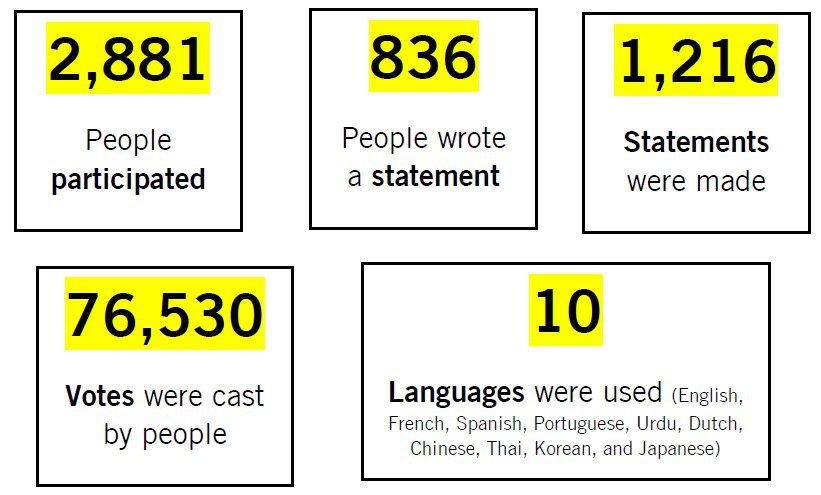The Global Strategy & Impact Programme at Amnesty International’s International Secretariat has been collecting input for the organisation’s next global strategy (#NextStrategy). This strategy aims to chart a direction that is future-proof, adaptive, and responsive – capable of keeping up with a rapidly evolving human rights landscape. We’ve collected input during the design process in various forms, including global events, blogs, and official submissions from external partners, national offices, and global teams. As an organisation that works with so many different types of actors, we noticed that we needed a way for members, volunteers, and staff to participate in their individual capacity rather than on behalf of an organisation or their profession. So, we found Pol.is.
Participatory & inclusive
Pol.is is an innovative online tool that is useful for civic participation and gathering open-ended feedback from the public. The tool combines aspects of a traditional survey, comment board, and voting system into one application. It allowed for users to submit their own opinions as well as vote on other people’s statements.


Another reason why we wanted to use this tool besides it being a participatory tool, was because of how inclusive it was from a language perspective. The tool automatically translated answers into the language of the users’s browser settings. We received statements in 10 languages including English, French, Spanish, Portuguese, Urdu, Dutch, Chinese, Thai, Korean, and Japanese (note: this is not representative of the regional spread of participants).
The concept of human rights is dated. New language is needed to address the realities of today
Example where 29% agreed, 44% disagreed, and 26% passed
Getting a sense of the movement
The tool runs statistical analyses on the voting patterns of participants, producing opinion groups and highlighting the statements that bring the groups together (consensus). It also surfaces statements that are the most contentious – where a roughly equal split between ’agrees’ and ’disagrees’ occurs. This gave us a sense of the movement besides the formal channels that currently exist; highlighting what individuals in the movement deem as important for the #NextStrategy. In our own qualitative assessment of the results, there are four key points that emerge overall.
1. Centrality of Amnesty International’s research
The centrality of Amnesty International’s research comes through strongly with a high level of consensus.
2. Investing in Human Rights Education (HRE)
Amnesty International should invest in Human Rights Education (HRE) and capacity-building to connect with others.
Engage with schools, involve grass-roots communities, use story telling / stories of change to demonstrate what worked/successes
Example where 87% agreed, 2% disagreed, and 10% passed.
3. Consider our use of language
Amnesty International should consider its use of language (and communication in general) as to how it can be more inclusive, accessible and resonate with the public.
4. Climate change – what level of priority should we allocate to it?
Climate change is an issue that featured strongly in all conversations – so while there is a clear sense that this is a very topical and important issue, there is disagreement as to what level of priority Amnesty International should allocate to it.
Amnesty should focus on climate change, as Amnesty won’t be able to stand up for human rights around the world if there is no world left.
Example where 40% agreed, 36% disagreed, and 23% passed
These opinions are part of a bigger reflection in the design of Amnesty International’s #NextStrategy – one that makes us a bigger, bolder, and more inclusive movement. The next steps include synthesising all the information we’ve received and having 3 task forces prototype a draft of what the next global strategy could look like. These task forces include a: Youth Task Force of youth leaders looking at Amnesty’s long-term influencing strategy; an Internal Capabilities Task Force specifically looking what this would mean for the organisation internally; and lastly a Thematic Task Force, that act as an advisory task force on whether our thematic ambitions make sense. Follow the rest of the process on https://isnextprd.wpengine.com and check out the detailed report of this survey in English, French, or Spanish. If you have any questions, reach out to our team at [email protected]


